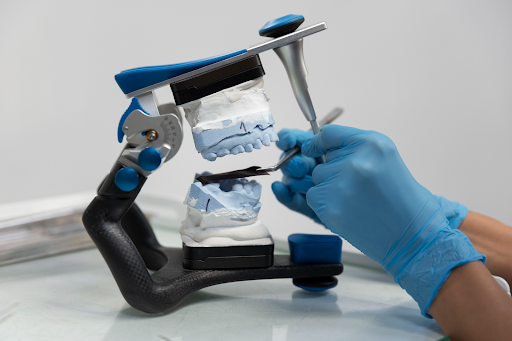Saturday - Wednesday: 9 AM - 10 PM
Thursday: 9 AM - 9 PM
Friday: Closed

July 22, 2025
How Are Dental Prosthetics Made To Match Your Natural Teeth?
Dental prosthetics today are not just about replacing missing teeth; they are about restoring your smile in the most natural way possible. With advancements in design and technology, patients now have access to highly customised solutions that blend seamlessly with their existing teeth. Diamond Dental combines modern equipment and experienced hands to deliver precision-crafted prosthetics that feel and look like real teeth for those seeking reliable dental prosthetic services in Kuwait. In this blog, we will explain how the process works, from evaluation to final fitting.
Why a Natural Look Matters in Dental Prosthetics
A natural appearance plays a major role in the success of any prosthetic treatment. When a dental prosthetic closely matches the colour, shape, and size of your existing teeth, it becomes nearly indistinguishable. This not only improves your smile but also boosts your confidence and comfort while speaking or eating. Choosing a trusted prosthetic service in Kuwait ensures that the aesthetic details are not overlooked. Skilled dental teams carefully study your real teeth to create a prosthetic that looks and feels right, making all the difference in your final result.
How Dentists Assess Your Natural Teeth Before Starting
Matching a prosthetic to your natural teeth starts with a detailed evaluation. The dentist closely examines the shape, size, and position of nearby teeth to ensure the new prosthetic blends in perfectly. Your bite is also assessed to understand how your teeth come together during chewing and speaking. This step helps in designing a prosthetic that is both functional and comfortable. Every feature, from tooth length to alignment, is considered during this stage, making it a key part of high-quality dental prosthetic services.
The Role of Digital Scanning and Imaging
Digital technology has changed the way dental prosthetics are designed and made. Instead of using uncomfortable molds, dentists now use advanced 3D scanners to take accurate digital impressions of your teeth and gums. These digital models offer a clear, detailed view of your oral structure, helping ensure the prosthetic fits perfectly.
Here’s how digital scanning adds value to the process:
- It captures even the smallest details of your teeth’s shape and alignment
- It reduces errors caused by traditional impression materials
- It speeds up the overall treatment timeline
- It improves patient comfort and reduces the need for multiple fittings
- It ensures a higher degree of accuracy for long-lasting dental prosthetics
How Tooth Shade and Texture Are Matched
Getting the color right is one of the most important parts of creating a natural-looking prosthetic. Dentists use a shade guide to compare and match the color of your existing teeth. In some cases, digital tools are used to analyse subtle differences in tone, transparency, and light reflection. This ensures the prosthetic does not stand out when you smile or speak.
Texture also plays a key role. Natural teeth have tiny surface details that reflect light in a certain way. These patterns are carefully replicated during the fabrication process to create dental prosthetics that look completely real.
What Materials Are Used for a Natural Finish?
The choice of material affects both the appearance and durability of the prosthetic. Common options include porcelain, zirconia, and composite resin. Porcelain and zirconia are especially popular because they reflect light in a way that closely mimics natural enamel. They are also strong enough to handle daily chewing and biting without easily wearing down.
Each material has its advantages depending on the location of the tooth, your bite, and aesthetic goals. Selecting the right material is a key part of delivering a successful prosthetic service by Diamond Dental that balances beauty with long-term performance.
How Skilled Lab Technicians Customize Each Piece
Once the scans and measurements are complete, the next stage involves the dental laboratory. Here, skilled technicians take the dentist’s specifications and begin crafting the prosthetic by hand. They shape it to match the exact size, contour, and surface texture of the natural teeth around it. The layering of materials is done with care to ensure a realistic finish.
The process also includes fine polishing and minor adjustments to match the color and translucency of real teeth. This level of detail is essential in delivering dental prosthetic services that are both aesthetically pleasing and durable.
Fitting and Adjustments for a Perfect Match
When the prosthetic is ready, it is fitted to check for alignment, comfort, and appearance. During this stage, the dentist ensures that the bite feels natural and the prosthetic blends in with nearby teeth. If needed, small changes are made on the spot to improve the fit or look.
This attention to detail makes sure the prosthetic does not cause discomfort or stand out visually. A well-executed dental prosthetic includes this careful trial phase to guarantee long-term comfort and confidence for the patient.
How the Final Prosthetic Is Placed and Secured
Once the prosthetic is finalized and approved, the dentist carefully places it in position. Depending on the type, crown, bridge, or denture, it is either cemented or securely attached using dental implants. Precision is key during this step to ensure the prosthetic fits comfortably and functions like a natural tooth.
After placement, the bite is checked again, and any minor refinements are made. The goal is to provide a stable and lasting result. A properly placed prosthetic is a vital part of successful dental prosthetic services provided by Diamond Dental, ensuring both comfort and long-term performance.
Can You Tell the Difference Between a Prosthetic and a Real Tooth?
In most cases, a well-designed prosthetic is almost impossible to tell apart from a natural tooth. When shade, shape, and surface texture are carefully matched, the result looks and feels natural. Even under close inspection, the difference is minimal, especially with high-quality materials and digital precision.
Patients often report that friends or family cannot tell which tooth was replaced. That is the true success of a well-executed dental prosthetics procedure when the artificial becomes indistinguishable from the real.
How to Care for Your Prosthetic to Keep It Looking Natural
Just like natural teeth, prosthetics need regular care to maintain their look and function. Brushing twice a day, using non-abrasive toothpaste, and flossing around the prosthetic are essential habits. If your prosthetic is removable, cleaning it as advised by your dentist will help prevent stains and wear.
Regular dental check-ups are also important. They allow early detection of any issues with the fit or condition of the prosthetic. Following a good oral hygiene routine ensures that your dental prosthetics can help extend the life of your prosthetic and keep your smile looking its best.
Conclusion
Matching dental prosthetics to your natural teeth is both an art and a science. From initial assessments and digital scans to careful craftsmanship and final placement, each step is designed to deliver a seamless result. With proper care and expert handling, the difference between a real tooth and a prosthetic becomes almost invisible.At Diamond Dental, we take pride in offering high-quality dental prosthetic services in Kuwait that focus on precision, comfort, and aesthetics. If you are considering restoring your smile, our experienced team is here to guide you every step of the way.
Search
Recent Posts
-
Top 10 Benefits of Dental Implants
19, Aug, 2025
-
What Is Tooth Decay? Causes, Symptoms, and Prevention
19, Aug, 2025
Looking for professionals & trusted medical healthcare?
Don't hesitate to contact us.

Contact Us
Get In Touch With Us
© 2024 All Right Reserved














